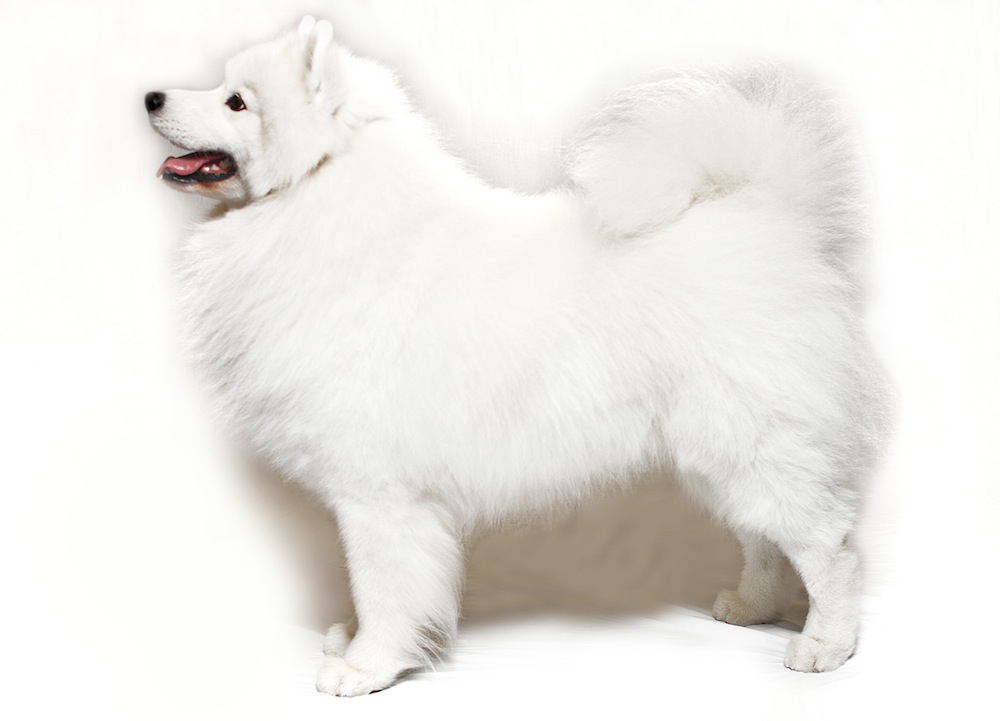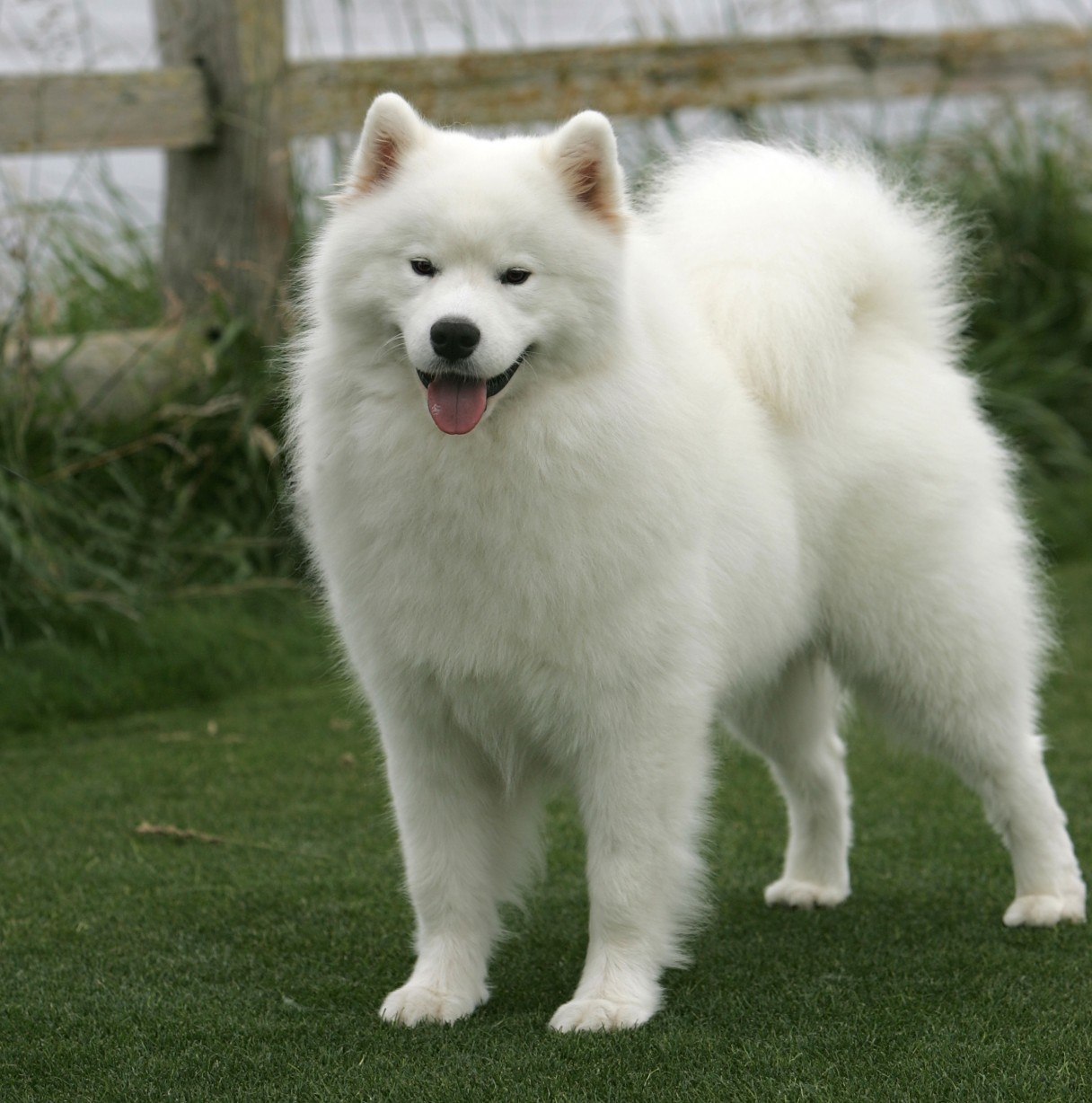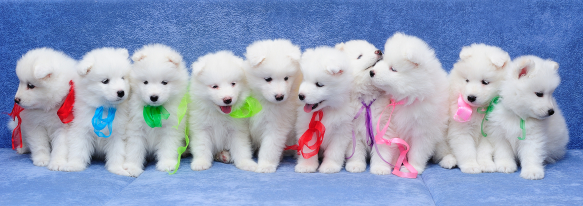
By Cheri Rankin
It all started when my daughter, Erin, wanted a “sled dog” for her fourth birthday (because she was enamored of sled-dog movies like Iron Will and Balto). I’ve been a dog lover all my life and had always had a dog growing up, but at that point we had not had a dog in the house as a family. So I did a little research into various sled-dog breeds. Malamutes were too big for us; Siberian Huskies were smaller, but just as independent. I ran a daycare in the house at the time, so the dog had to be good with kids. Samoyeds were the answer. One of their original jobs in Siberia, in addition to herding reindeer, was “herding” the children and keeping their people warm at night.  Falling in Love WIth the Breed I called a former boss who I knew had raised Samoyeds at one point, and he told me he had a 6-month-old male who was temporarily living with his sister-in-law’s family, and if I wanted him, I could have him. For free. And so it began… I had grown up with a black Lab. We also had a Boxer at one point, a Saint Bernard, and a menagerie of my Dad’s hunting dogs. This dog was different, however. He was like Nana from Peter Pan. He adored “his” child. He slept with Erin every night. We often found them curled up together for naps. He was an old soul from the beginning, gentle and easy with the kids. Multiple kids perfected their walking skills cruising across the house, hanging onto Rollie’s fur. I was hooked on the Samoyed breed, because their connection to humans and their desire to truly be part of our pack was something I had not seen before. We got involved in Samoyed rescue, to help with Sammies who ended up in shelters or who were owner-surrendered. We were “failed fosters” twice, adopting two of our older rescue girls. I’ve heard it said that Sammies are like potato chips, that “you can’t have just one.” This was certainly true in our case! When my kids both went to school full-time in 2000, I went back to college for a career change. Seven years later I finished my Ph.D. in English — and for a “Ph.D. completion” gift for myself, I bought myself (what else?) a puppy … a Samoyed puppy. I found a breeder, drove to Minnesota, and came home with an 8-week-old baby. We named him Ray. That was the beginning of showing and breeding Samoyeds. I got Ray with the possibility in mind of showing him. I bought all the equipment and started taking him (and myself) to classes. I grew up on a farm and had shown hogs in 4-H, but this dog-showing thing was new. There was a steep learning curve — I was clueless in the beginning, and I had a headstrong boy, but eventually we figured it out. Ray finished his AKC championship in 2009, and by then I was hooked on dog shows. I found a wonderful circle of friends who made it fun amidst the competition, I got to show off my boy (whom I absolutely adore), and occasionally we got to bring home some nice ribbons.
Falling in Love WIth the Breed I called a former boss who I knew had raised Samoyeds at one point, and he told me he had a 6-month-old male who was temporarily living with his sister-in-law’s family, and if I wanted him, I could have him. For free. And so it began… I had grown up with a black Lab. We also had a Boxer at one point, a Saint Bernard, and a menagerie of my Dad’s hunting dogs. This dog was different, however. He was like Nana from Peter Pan. He adored “his” child. He slept with Erin every night. We often found them curled up together for naps. He was an old soul from the beginning, gentle and easy with the kids. Multiple kids perfected their walking skills cruising across the house, hanging onto Rollie’s fur. I was hooked on the Samoyed breed, because their connection to humans and their desire to truly be part of our pack was something I had not seen before. We got involved in Samoyed rescue, to help with Sammies who ended up in shelters or who were owner-surrendered. We were “failed fosters” twice, adopting two of our older rescue girls. I’ve heard it said that Sammies are like potato chips, that “you can’t have just one.” This was certainly true in our case! When my kids both went to school full-time in 2000, I went back to college for a career change. Seven years later I finished my Ph.D. in English — and for a “Ph.D. completion” gift for myself, I bought myself (what else?) a puppy … a Samoyed puppy. I found a breeder, drove to Minnesota, and came home with an 8-week-old baby. We named him Ray. That was the beginning of showing and breeding Samoyeds. I got Ray with the possibility in mind of showing him. I bought all the equipment and started taking him (and myself) to classes. I grew up on a farm and had shown hogs in 4-H, but this dog-showing thing was new. There was a steep learning curve — I was clueless in the beginning, and I had a headstrong boy, but eventually we figured it out. Ray finished his AKC championship in 2009, and by then I was hooked on dog shows. I found a wonderful circle of friends who made it fun amidst the competition, I got to show off my boy (whom I absolutely adore), and occasionally we got to bring home some nice ribbons.  Getting Started in Breeding: Rewards and Heartbreak Ray’s first litter was born in July 2010, in Minnesota. Coming from a long line of livestock farmers who’ve bred and shown cattle, hogs, and sheep, breeding and showing my own dogs seemed like a natural turn of events. The first pups were born here in October 2012. Anyone who thinks dog breeders just sit back and haul in the money honestly doesn’t have a clue. If you’re doing it right, you’re testing beforehand for any genetic issues in your breeding stock. In this breed, at a minimum, you’re getting their eyes cleared every year and having their hips X-rayed at 2 years for hip dysplasia. In our breed it’s also desirable to run genetic tests for a couple of known diseases and get a cardiac clearance. Tests are not cheap. And thought it hasn’t happened here yet, there’s always a chance that you put your heart and soul into a dog for two years, only to find that he or she doesn’t pass one of those tests — and though you don’t love that dog one whit less, he or she can’t be used for breeding. Sometimes it takes time and some veterinary intervention to get the female pregnant (which can be draining both financially and emotionally). And sometimes pregnancies end with C-sections — in the worst-case scenario, emergency C-sections. You lose puppies. That’s happened here, and it was a heartbreaking reminder that Mother Nature can indeed be cruel. Breeding animals of any sort is not for the weak at heart — and breeding an animal who is part of your family, who lives in your house? Every time, you’re putting a lot on the line. Including your heart. We screen all potential homes, asking lots of questions and spending lots of time to make sure those homes will be safe and happy ones for our babies. We keep in touch with people and live for the occasional photo that comes attached to an update e-mail, or the Christmas-card photo with the dog happily ensconced as part of the family. We write contracts that are for the lifetime of the dog, which say that if the new owners cannot keep the dog for any reason, the dog comes back to the breeder — because we are responsible for bringing them into the world, and we want to know where they are and how they are living for the rest of their lives. Most dog breeders keep at it, despite the financial costs and occasional heartbreak, because watching those babies come into the world and holding them in your hands is one of the most rewarding things we can imagine, as is the joy you can see and feel when someone takes one of your puppies into their family.
Getting Started in Breeding: Rewards and Heartbreak Ray’s first litter was born in July 2010, in Minnesota. Coming from a long line of livestock farmers who’ve bred and shown cattle, hogs, and sheep, breeding and showing my own dogs seemed like a natural turn of events. The first pups were born here in October 2012. Anyone who thinks dog breeders just sit back and haul in the money honestly doesn’t have a clue. If you’re doing it right, you’re testing beforehand for any genetic issues in your breeding stock. In this breed, at a minimum, you’re getting their eyes cleared every year and having their hips X-rayed at 2 years for hip dysplasia. In our breed it’s also desirable to run genetic tests for a couple of known diseases and get a cardiac clearance. Tests are not cheap. And thought it hasn’t happened here yet, there’s always a chance that you put your heart and soul into a dog for two years, only to find that he or she doesn’t pass one of those tests — and though you don’t love that dog one whit less, he or she can’t be used for breeding. Sometimes it takes time and some veterinary intervention to get the female pregnant (which can be draining both financially and emotionally). And sometimes pregnancies end with C-sections — in the worst-case scenario, emergency C-sections. You lose puppies. That’s happened here, and it was a heartbreaking reminder that Mother Nature can indeed be cruel. Breeding animals of any sort is not for the weak at heart — and breeding an animal who is part of your family, who lives in your house? Every time, you’re putting a lot on the line. Including your heart. We screen all potential homes, asking lots of questions and spending lots of time to make sure those homes will be safe and happy ones for our babies. We keep in touch with people and live for the occasional photo that comes attached to an update e-mail, or the Christmas-card photo with the dog happily ensconced as part of the family. We write contracts that are for the lifetime of the dog, which say that if the new owners cannot keep the dog for any reason, the dog comes back to the breeder — because we are responsible for bringing them into the world, and we want to know where they are and how they are living for the rest of their lives. Most dog breeders keep at it, despite the financial costs and occasional heartbreak, because watching those babies come into the world and holding them in your hands is one of the most rewarding things we can imagine, as is the joy you can see and feel when someone takes one of your puppies into their family.  Turning Around Anti-breeder Sentiment I also have to say that one of the most difficult things about being a dog breeder is the current political/legislative climate. We all know that dogs wind up in shelters, and many are euthanized. I’d like to suggest that that’s not so much a breeder problem as it is a responsibility problem. Responsible breeders send puppies out into the world with a lifetime safety net. However, a lot of dogs that are out in the world don’t come from responsible breeders. They come from all sorts of sources: the person who wants to breed his or her dog “just one time” because “my dog is so cute,” or because “I want another one just like him,” or because “my kids need to see the miracle of birth.” They come from people who get an intact male or female and let it breed indiscriminately because they don’t (or won’t) have it spayed or neutered or don’t keep their female confined during her season. Shelters are filled with owner-surrenders, where people had gotten a dog and didn’t know what they were getting into or were unwilling to live up to the lifelong commitment to the pet they’d purchased. Most of us in the purebred world do all we can to make absolutely certain none of our puppies end up in this system. That’s not to say that it never happens, when people don’t honor their contracts, but we really try. However, as a result of the shelter/euthanasia issue, we all get lumped in together. The animal-rights movement paints any and all breeders as “puppy mills,” and we’re gradually being regulated and legislated out of existence. We’ve all heard “Adopt, don’t shop,” with adoption being perceived as somehow more rewarding or politically correct. Well, I’m here to tell you that it’s perfectly fine to get a dog from whatever source you’d like, as long as you do your research, search your heart, and make a commitment — a commitment for the dog’s lifetime. Get the dog you want, and keep him. Love him, and get love in return. That’s what it’s all about, in the end. —Cheri Rankin, guest columnist, Samoyed Club of America (January 2015 AKC Gazette) Further information about Samoyeds can be found here and on the website of the breed’s national parent club, the Samoyed Club of America. Read more AKC Gazette breed columns here, and follow us on Facebook and Twitter.
Turning Around Anti-breeder Sentiment I also have to say that one of the most difficult things about being a dog breeder is the current political/legislative climate. We all know that dogs wind up in shelters, and many are euthanized. I’d like to suggest that that’s not so much a breeder problem as it is a responsibility problem. Responsible breeders send puppies out into the world with a lifetime safety net. However, a lot of dogs that are out in the world don’t come from responsible breeders. They come from all sorts of sources: the person who wants to breed his or her dog “just one time” because “my dog is so cute,” or because “I want another one just like him,” or because “my kids need to see the miracle of birth.” They come from people who get an intact male or female and let it breed indiscriminately because they don’t (or won’t) have it spayed or neutered or don’t keep their female confined during her season. Shelters are filled with owner-surrenders, where people had gotten a dog and didn’t know what they were getting into or were unwilling to live up to the lifelong commitment to the pet they’d purchased. Most of us in the purebred world do all we can to make absolutely certain none of our puppies end up in this system. That’s not to say that it never happens, when people don’t honor their contracts, but we really try. However, as a result of the shelter/euthanasia issue, we all get lumped in together. The animal-rights movement paints any and all breeders as “puppy mills,” and we’re gradually being regulated and legislated out of existence. We’ve all heard “Adopt, don’t shop,” with adoption being perceived as somehow more rewarding or politically correct. Well, I’m here to tell you that it’s perfectly fine to get a dog from whatever source you’d like, as long as you do your research, search your heart, and make a commitment — a commitment for the dog’s lifetime. Get the dog you want, and keep him. Love him, and get love in return. That’s what it’s all about, in the end. —Cheri Rankin, guest columnist, Samoyed Club of America (January 2015 AKC Gazette) Further information about Samoyeds can be found here and on the website of the breed’s national parent club, the Samoyed Club of America. Read more AKC Gazette breed columns here, and follow us on Facebook and Twitter.

